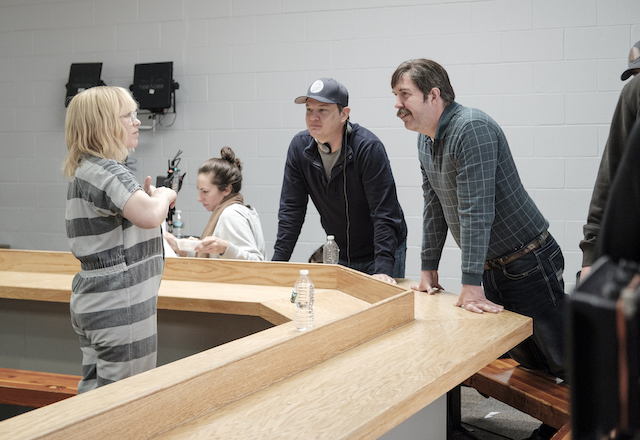Escape At Dannemora could have been a typical docu-drama prison escape mini-series based on a true story. Screenwriters Brett Johnson, who boasts writing credits on Mad Men and Castle, and Michael Tolkin who wrote Deep Impact and The Player, took great care to craft a considered, prestige drama about deeply flawed characters searching for happiness. The show creators spoke to Creative Screenwriting Magazine about their writing process.
Brett Johnson and Michael Tolkin met while writing another Showtime hit Ray Donavan. While working on their second episode together, producer Bryan Zuriff told the writing duo to turn on the news and catch up on the recent prison break at the Clinton Correctional Facility in New York. “This was about five days into the manhunt,” recalled Johnson. “We were taken by these three individuals in the news.” The immediacy, boldness, and uniqueness of the story prompted them to write Dannemora.
The prison break occurred partially due to a romance between a New York prison employee, Tilly Mitchell and two inmates, David Sweat and Richard Matt.Directed by Ben Stiller (who was long searching for a drama project), the series stars Benicio Del Toro as Richard Matt, Paul Dano as David Sweat, and Patricia Arquette as Tilly Mitchell.

Michael Tolkin & Brett Johnson
The characters were very unique and the writers presented them as such. Richard Matt was known as a painter in the prison, while David Sweat appeared to be a man with a heart of gold, and the “mind of an engineer.” Although Tilly was having an affair with these gentlemen, she couldn’t go through with the final step they needed to escape.
“It was all kind of magical,” said Johnson. To capture the magic, the writers decided not to focus on any one character as the lead. “It’s about all of them,” asserted Tolkin. “The story of any one of them without the other would be diminished.”
Creating Character Conflict
“All of these characters seem to be real people who seemed to be dissatisfied with their lives. They wanted to do something about it. We wanted to show those separate sides and put them next to each other and explore them. We don’t try to tell you what to think about that, but just put them there side by side.”
The screenwriters’ character perspective on the trio (Sweat, Matt, and Tully) is somewhere between criminal and victim. Tolkin said, “I don’t think their nature is locked in at the beginning or locked in at the end. One of the things we did in chapter six was to really isolate what brought them to Dannemora from the rest of the story. We were able to explore it without resorting to backstory or flashback. So we can deal with these people in the current dilemma of their lives, as people present in the current story, not in the past.”
Johnson added, “I think you get a license when you’re writing a true story to not have the obligation of writing a good guy and a bad guy. Nobody is entirely good or bad. That was the other thing that freed us. You didn’t get that note of, ‘Why isn’t Tilly more likable.’ Well, this is who that woman really is. You end up getting to tell a story of flawed characters.”
Tolkin was also drawn to the story of Dannemora because of the fascination with art the characters shared. Painting was the first form of metaphorical escape the inmates and the prison guard shared. “The prison world can be isolating. Art can be a way of liberating your spirit. That’s the human response and human need, to make art. When you have a prisoner serving life, art can be his way out.”
Mental and Physical Escape
Richard Matt had paintings of Oprah Winfrey, Hilary Clinton, Julia Roberts, Angelina Jolie Barack Obama and various other people who had accomplished great things. It spoke to their aspirational thinking of greater things. “The guard selected paintings, so Matt had an audience. Matt was good, but that escape wasn’t enough. He needed a greater escape, which was breaking through the prison walls.”
The actual escape happened in 2015 a few years before the TV series, but the writers began their research right away. They met with David Sweat, but several other people declined to meet for an interview. They wrote two drafts of Dannemora simply from newspaper information, but later they were given transcripts from the prison.
“The official police reports became the series bible. You learn a lot about being a detective when you read a lot of transcripts. You hear the same story multiple times, so you start to see what is true and what is not true. That’s a good research method, to ask the same question to five different people. You’re going to get five different answers when you start to realize the truth.” Johnson and Tolkin became bona fide detectives during the writing process. They could factualize and dramatize the events equally.
One major earth-shaking moment came from David Sweat’s transcript when there was an anonymous note that said he was going into a backroom with Tilly. For Sweat, he lost his job, his freedoms, and his interaction with Tilly all at once. It was an eye-opening moment because the little things he did have were suddenly taken away. Most shows reveal murders and violence in prison, but taking away small freedoms is also a harsh form of punishment. “Sweat lost his job. Matt was upset about shaving gel and shaving cream. That’s a more subtle and interesting way to show loss of freedom if depicted the right way.”

To attract major talent to the project, Tolkin said they “wrote the hell out of it.” The unique viewpoints came out from real life, but the TV writers shaped the characters for A-list talent. Also, Ben Stiller came on board and created a vision for the piece. “Ben Stiller was a big reason we were able to put that cast together. The good news is that you can get movie stars to do TV right now, but the bad news is that you have to get movie stars to do TV right now…”
Pacing, Dialogue, and Tone
Stiller’s approach, along with the script, showcased a vision with minimal dialogue, so deliberate pacing was vital. “We didn’t want a prison break in the first episode,” said Johnson. “Our goal with the first episode was to get into these characters and make you forget there was going to be a prison break. We wanted to do something different from the traditional laundry hamper and the guards changing shifts.”
The writers added that most major stars are being forced to take on good guy-bad guy roles, such as the franchise hits, television presents the landscape to make stories about anti-heroes and morally gray-area characters. “There are a lot of actors of high caliber where it’s not stretching them to be a good guy or bad guy. Our goal was to feel that feeling and attract others who wanted to experience that feeling. But, without Ben Stiller, there would never have been that trust. Actors want someone they can trust.”
As for the role of Tilly, they had to make her as dissatisfied as the prisoners to form a natural thematic as well as character bond with them. In the first episode, a snowplow covers her car with snow. She’s not happy in her marriage. “We built her dream of happiness with the fantasy Matt painted for her of going to Mexico.”
As for the fugitives, the characters change through the story. Outside of the prison walls, we see the true colors shine through in each of the two men.
“The friendship story between Matt and Sweat was always something we felt as poignant. I don’t know what it says about friendship, but it says something about human nature. When we met with David Sweat, we asked why he didn’t leave on the dry run. He said, ‘It never occurred to me to leave.’ He thought they were friends, but in the end, he left. I think he came to realize that if the positions were reversed, Matt would have not gone back to prison. There seemed to be something tragic. Sweat may have gotten away.”
Overall, the writers knew how they wanted to approach the TV series and what they wanted to avoid. “It’s a variation on the prison movie. Tonally, the movie we always talked about was Dog Day Afternoon, which was also based on a true story, and which was also about people who may not be the most sophisticated criminals on the planet. But, that movie makes you feel like you’re there with them. There is this large friendship-betrayal element.”
“Escape At Dannemora is a story about people dissatisfied with their lives. I think David Sweat found some type of peace when he was captured. In the end, for Tilly, we tried to show that the thing making her unhappy didn’t have to do with any of the things she thought. It had to do with something inside of her. Did she do anything about the underlying problem? I think David Sweat did confront those themes of happiness is found within. I think he also felt accomplishment in what he achieved, despite the fact he was eventually caught.”

